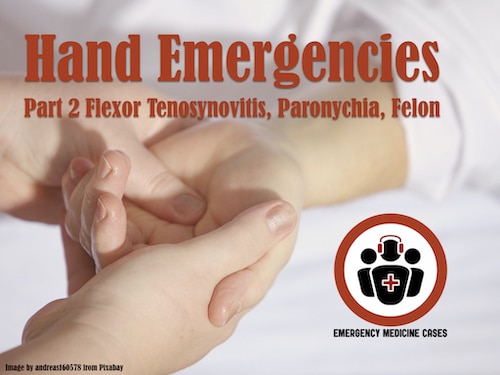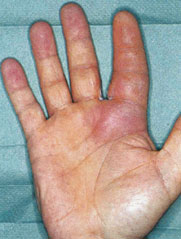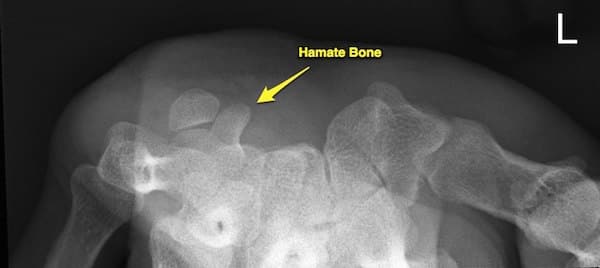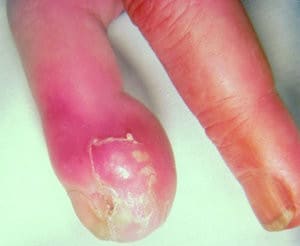Part 2 of Hand Emergencies
with Dr. Laura Tate & Dr. Andrew Arcand
Flexor Tenosynovitis
4 cardinal signs (Kanavel signs):
- Finger held in slight flexion,
- Fusiform swelling of the digit,
- Tender along tendon sheath, &
- Pain with passive extension.
Time is key because adhesions can form and permanently disable the digit. These must be urgently evaluated by plastic surgery, treated with IV antibiotics, and often admitted for either close monitoring, or urgent surgical irrigation and drainage. Start antibiotics, splint and elevate the hand, and refer to plastics.
Hook of the Hamate Fracture
Mechanism – either FOOSH, or an impact of a club or racket forced into the palm. Hook of the hamate fractures may not be seen on usual Xray views of the hand. The “carpal view” (supinated lateral view) should be ordered if suspicious about this fracture, and/or if pain is felt over the hypothenar eminence.
Not all hamate fractures appear on Xray. Some need further imaging (CT), and nonunion is very common. Excision of the fracture fragment is often necessary if there is nonunion. If a fracture is seen, immobilize the hand (in a volar slab, with MCP joints in flexion) and refer for follow-up within 4 weeks.
Paronychia
- Paronychia (nail edge infections, image at right) should be managed depending on the extent of the infection. A small infection without an abscess may improve with soaking the finger, and oral antibiotics.
- However, if an abscess has formed, it needs blunt dissection with a surgical blade, elevation of the lateral nail fold (image at right) and drainage of the sulcus between the lateral nail plate and the lateral epithelium.
- Irrigate copiously, and instruct the patient to soak the finger to keep the abscess open, or place a wick.
- If the abscess tracks under the nail, consider wedge resection of the nail plate, or nail plate removal if the entire nail plate is involved.
Felon
Compartments of the volar skin may form abscesses which need careful and thorough surgical decompression. See image (right). If urgent referral to a hand surgeon is not available, these must be managed in the ED. Cut and detach septae along whole length of distal phalanx nearest to the abscess site, releasing and irrigating very thoroughly. Avoid making incisions across the lateral aspect, to avoid injuring the digital nerve. After releasing all septae, swab, pack and treat with IV antibiotics, splinting, and elevation. Ensure urgent follow-up.
Tips for Hand Injuries
- When considering when to remove sutures in the hand, leave sutures that are over areas of tension (i.e. over a joint) for longer (at least 12 days) so they heal completely.
- If controlling bleeding is an issue, do NOT clamp any digital arteries, as the digital nerve is very nearby and hard to visualize. Use pressure, limited tourniquet and elevation to control bleeding safely.
- Prophylactic antibiotics are indicated for for all animal bites to the hand, and for certain complex injuries (crush wounds, wounds over a joint, or for immune compromised patients).
- If referring a hand abscess to a clinic, consider swabbing the drained fluid so MRSA status can be determined.
- Immobilizing the PIP joint in extension can stiffen the collateral ligaments causing permanent disability, so don’t splint PIP joint for greater than 1–2 weeks unless necessary, and if splinting, ensure an early referral time. (within 1–2 weeks).
References
Smith III, Purcell, et al. “Excision of the hook of the hamate: a retrospective survey and review of the literature.” The Journal of hand surgery 13.4 (1988): 612-615. www.ncbi.nlm.nih.gov/pubmed/?term=Smith+P+et+al.…
For More on Hand Emergencies on EM Cases:
Best Case Ever 14: High Pressure Injection Injury
Episode 29: Hand Emergencies
More FOAMed Resources on Hand Emergencies
Kevin Rodgers on Free EM Talks
Dr. Helman has no conflicts of interest to declare










Leave A Comment